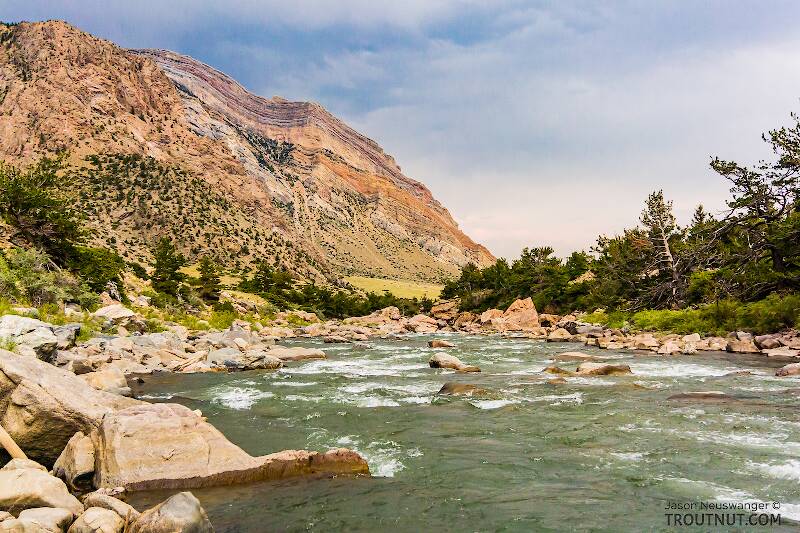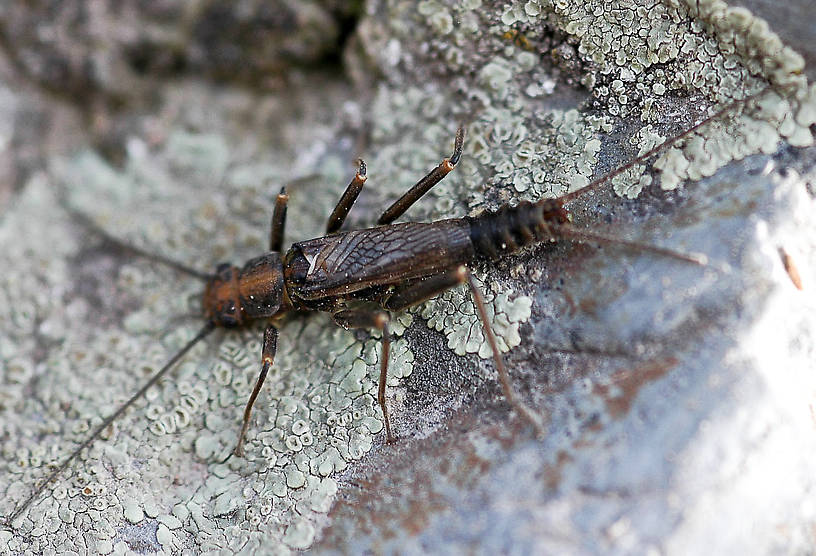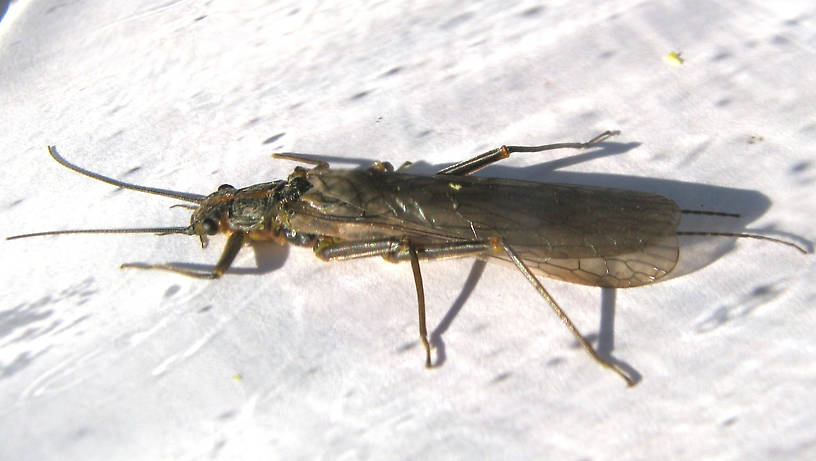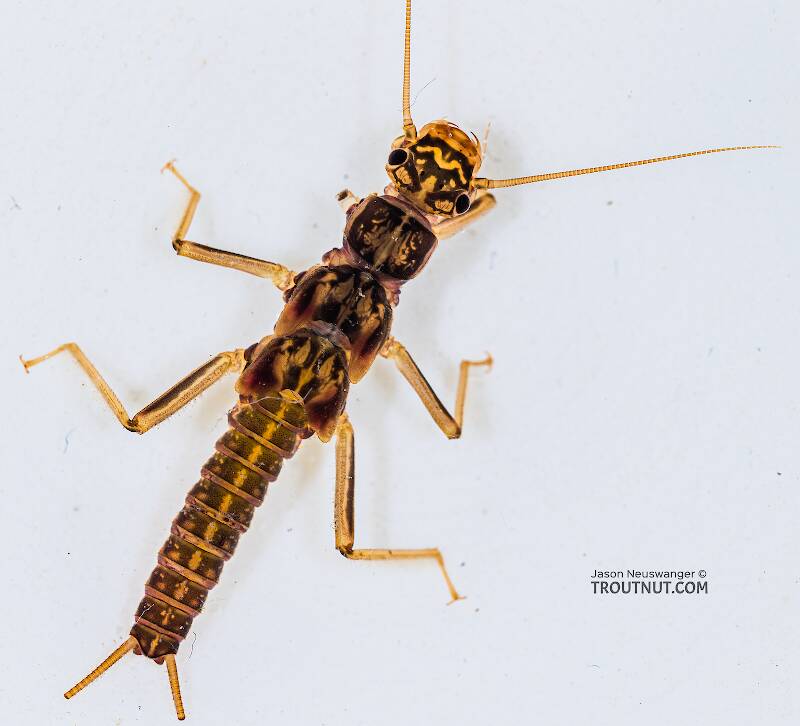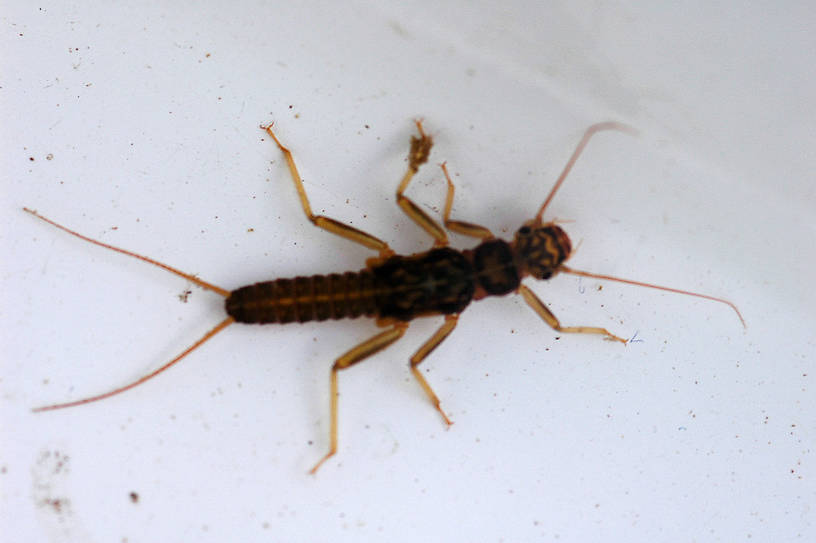
Salmonflies
Pteronarcys californica
The giant Salmonflies of the Western mountains are legendary for their proclivity to elicit consistent dry-fly action and ferocious strikes.
Featured on the forum

Troutnut is a project started in 2003 by salmonid ecologist Jason "Troutnut" Neuswanger to help anglers and
fly tyers unabashedly embrace the entomological side of the sport. Learn more about Troutnut or
support the project for an enhanced experience here.
Stonefly Genus Skwala (Large Springflies)
The genus Skwala (Short-winged Springflies) of the Perlodidae family is represented by three species in North America, Skwala americana, the identical-looking Skwala curvata, and Skwala compacta. Skwala should be included in any comprehensive list of important stoneflies for the western flyfisher. Though often mistakenly thought of as members of the Perlidae (Golden Stones) that happen to hatch early, they are actually quite different and often far more important on many western rivers than their more publicized cousins. Perhaps the most significant factors regarding this growing recognition are their inhabiting tailwaters previously too warm for trout and the lengthening of trout seasons, both relatively recent phenomena. This explains the scant mention they have received (if any) in older angling literature.
Excepting the lake dwelling compacta, they are lovers of cobble bottomed riffles and runs of larger mid to low elevation rivers. Their behavior is consistent with other large stoneflies except that they are more prone to floating long distances as they placidly oviposit, and with the exception of Pteronarcys californica (Salmon Flies) in some locations, they do it in larger numbers. There is usually no challenge to them for the fish's attention until Rhithrogena morrisoni (March Brown) mayflies begin to appear a few weeks later. Their flights occur during the warmest part of the day which usually means in the afternoon, though impressive flights have been observed around the lunch hour. Regardless, they finish well before dark.
The river-dwelling adults have smoky brown to brown wings, brown legs, and either primrose (often tinged w/ olive) abdomens ribbed with brown or the reverse in darker strains. The males are brachypterous, smaller and usually darker. Both sexes thoracic ventrals are a curiously marked yellow/dark brown variegated pattern. Gravid females carry blackish pea shaped egg clusters off the tips of their abdomens that are much larger in diameter.
Excepting the lake dwelling compacta, they are lovers of cobble bottomed riffles and runs of larger mid to low elevation rivers. Their behavior is consistent with other large stoneflies except that they are more prone to floating long distances as they placidly oviposit, and with the exception of Pteronarcys californica (Salmon Flies) in some locations, they do it in larger numbers. There is usually no challenge to them for the fish's attention until Rhithrogena morrisoni (March Brown) mayflies begin to appear a few weeks later. Their flights occur during the warmest part of the day which usually means in the afternoon, though impressive flights have been observed around the lunch hour. Regardless, they finish well before dark.
The river-dwelling adults have smoky brown to brown wings, brown legs, and either primrose (often tinged w/ olive) abdomens ribbed with brown or the reverse in darker strains. The males are brachypterous, smaller and usually darker. Both sexes thoracic ventrals are a curiously marked yellow/dark brown variegated pattern. Gravid females carry blackish pea shaped egg clusters off the tips of their abdomens that are much larger in diameter.
Where & when
In CA, their emergence runs for a few weeks to a month or more and can start as early as mid January, depending on the year. Years with cold Januarys and/or lacking an early February "false spring" can delay them until the end of February or even running well into March. These dates are much later north of Southern Oregon and east of the Sierra's. They are reported even later in the northern Rockies.
In 5 records from GBIF, adults of this genus have been collected during July (40%), May (40%), and June (20%).
In 1 record from GBIF, this genus has been collected at elevation of 2428 ft.
Genus Range
Hatching behavior
Habitat: cobble riffles and runs
Egg-Laying behavior
Time of day: Warmest part of the day
Habitat: Same as emerging
Nymph biology
Current speed: moderate to fast
Substrate: cobble
Specimens of the Stonefly Genus Skwala
1 Male Adult
2 Female Adults
3 Nymphs
Discussions of Skwala
Arcynoptryx compacta name change
6 replies
Posted by Bnewell on Jul 26, 2012
Last reply on Jul 28, 2012 by Entoman
In a recent publication the name of this species was changed to Skwala compacta.
Skwala
9 replies
Posted by Entoman on Jan 16, 2011
Last reply on Nov 2, 2011 by Sayfu
The genus Skwala (Short-winged Springflies) of the Perlodidae family should be included in any comprehensive list of important stoneflies for the western flyfisher. Though often mistakenly thought of as perlids (Golden Stones) that happen to hatch early, they are actually quite different and often far more important than their highly publicized cousins on many western rivers. Perhaps the most significant factors regarding the growing recognition of their importance are their inhabiting tailwaters and the lengthening of trout seasons, both relatively recent phenomena. This goes a long way in explaining the scant mention they have received in older angling literature.
Where Skwalas are found in such incredible numbers are mostly the low elevation tailwaters. These rivers flowed much too warm in the Summer and early Fall to sustain trout fisheries prior to the extensive dam projects of the 50's and 60's. So... nobody in our fraternity paid much attention to the bug life. Whether the Skwalas were already there and adapted to the cooler water or migrated from higher elevations is an interesting conjecture. A popular theory is that these tailwaters are rapidly evolving ecosystems that are only now settling into their established fauna that include the now very important Skwala and ... trout! It makes sense to me.
In CA, their emergence runs for a few weeks to a month and can start as early as mid January, depending on the year. Years in which we miss a February "false spring" following a cold January can delay them until the end of the month running well into March. These dates are undoubtedly much later north of Southern Oregon and east of the Sierra's. They are reported even later in the northern Rockies.
What little information that does exist about the genus Skwala in flyfishing literature is often misplaced with other genera or treated in short footnotes as insignificant. There also seems to be a lot of confusion among knowledgable anglers between this genus and Paraperla, which is of an entirely different family (Chloroperlidae). Ernest Schwiebert in his revised addition of "Nymphs" listed Paraperla paralella as a hatch of some significance out west. In footnotes related to this species, he mentions that some entomologists are considering placing this species in the Skwala genus. This footnote is the only reference to Skwala in the entire book and the genus isn't listed in the extensive index covering hundreds of far more obscure species. His comment only adds to the confusion. Especially since he accurately describes Paraperla's physical characteristics, which are at odds with those of Skwala. Moving species among genera while retaining their specific names is one thing but moving them to entirely different families already in existence is problematic. Perhaps the confusion comes from shared specific names by the two different genera in older taxonomies that do list Skwala paralella as a valid name that has since been dropped.
What we call them aside, there is no confusion about the differences in their appearance. Paraperlas are very slender (not unlike the dark winter stones) and less noticeably segmented than would normally be associated with Perlodids. They are more monochromatic and usually lack pronounced patterning on their dorsal surfaces. They cannot be mistaken for the much stockier and stipple backed Skwalas, who's tails and antenna are also more than twice as long.
Because of this confusion over nomenclature maybe reports by anglers of "Skwalas" from other regions of the West that are described as strongly olivaceous in color are in fact referring to Chloroperlids and not Perlodids? This needs to be sorted out.
Lovers of large cobble bottomed riffles and runs, their behavior is consistent with other large stoneflies except that they are more prone to floating long distances as they placidly oviposit... And with the exception of the pteronarcids (Salmon Fly) in some locations, they do it in larger numbers. There is usually no challenge to them for the fishes attention until the March Browns (Rhithrogena morrisoni) begin to appear a few weeks later. Their flights occur during the warmest part of the day which usually means in the afternoons. I have also fished over impressive flights around the lunch hour. They finish well before dark.
The female nymphs run approx. 22 mm in body length with tails and antenna as long as their bodies. The males are substantially smaller. In build and markings, they superficially resemble the larger Perlids (Golden Stones), but are less stout and colored a bit differently with greater contrast between ventral and dorsal surfaces. The large perlid nymphs tend to be dark patterned amber (oak turkey wing) dorsally over pale amber ventrals; Skwala nymphs are even darker patterned brown (turkey tail) over primrose.
The adults have smoky brown wings, brown legs, and primrose abdomens ribbed with brown or the reverse. The males are brachypterous (very short winged). Their curiously marked sternites are perfectly matched by the yellow/black variegated chenille when its wrapped on a hook (to bad it doesn't float well). Gravid females carry black, pea shaped egg clusters off the tips of their abdomens that are larger in diameter than their abdomens. Folding a section of black foam to stick out beyond the hook bend is a wise addition to some of your dry imitations in case you find fish attracted to the those that have yet to drop their eggs.
Unfortunately, another trait they share with other large stonefly genera is their propensity for cyclic population densities. Frankly, many of the western large stonefly genera appear to be in a down cycle from their peaks of a few years ago in a lot of locations, and their present populations on some of the rivers I fish are nothing like the "blizzards" we saw in the 70's.
Where Skwalas are found in such incredible numbers are mostly the low elevation tailwaters. These rivers flowed much too warm in the Summer and early Fall to sustain trout fisheries prior to the extensive dam projects of the 50's and 60's. So... nobody in our fraternity paid much attention to the bug life. Whether the Skwalas were already there and adapted to the cooler water or migrated from higher elevations is an interesting conjecture. A popular theory is that these tailwaters are rapidly evolving ecosystems that are only now settling into their established fauna that include the now very important Skwala and ... trout! It makes sense to me.
In CA, their emergence runs for a few weeks to a month and can start as early as mid January, depending on the year. Years in which we miss a February "false spring" following a cold January can delay them until the end of the month running well into March. These dates are undoubtedly much later north of Southern Oregon and east of the Sierra's. They are reported even later in the northern Rockies.
What little information that does exist about the genus Skwala in flyfishing literature is often misplaced with other genera or treated in short footnotes as insignificant. There also seems to be a lot of confusion among knowledgable anglers between this genus and Paraperla, which is of an entirely different family (Chloroperlidae). Ernest Schwiebert in his revised addition of "Nymphs" listed Paraperla paralella as a hatch of some significance out west. In footnotes related to this species, he mentions that some entomologists are considering placing this species in the Skwala genus. This footnote is the only reference to Skwala in the entire book and the genus isn't listed in the extensive index covering hundreds of far more obscure species. His comment only adds to the confusion. Especially since he accurately describes Paraperla's physical characteristics, which are at odds with those of Skwala. Moving species among genera while retaining their specific names is one thing but moving them to entirely different families already in existence is problematic. Perhaps the confusion comes from shared specific names by the two different genera in older taxonomies that do list Skwala paralella as a valid name that has since been dropped.
What we call them aside, there is no confusion about the differences in their appearance. Paraperlas are very slender (not unlike the dark winter stones) and less noticeably segmented than would normally be associated with Perlodids. They are more monochromatic and usually lack pronounced patterning on their dorsal surfaces. They cannot be mistaken for the much stockier and stipple backed Skwalas, who's tails and antenna are also more than twice as long.
Because of this confusion over nomenclature maybe reports by anglers of "Skwalas" from other regions of the West that are described as strongly olivaceous in color are in fact referring to Chloroperlids and not Perlodids? This needs to be sorted out.
Lovers of large cobble bottomed riffles and runs, their behavior is consistent with other large stoneflies except that they are more prone to floating long distances as they placidly oviposit... And with the exception of the pteronarcids (Salmon Fly) in some locations, they do it in larger numbers. There is usually no challenge to them for the fishes attention until the March Browns (Rhithrogena morrisoni) begin to appear a few weeks later. Their flights occur during the warmest part of the day which usually means in the afternoons. I have also fished over impressive flights around the lunch hour. They finish well before dark.
The female nymphs run approx. 22 mm in body length with tails and antenna as long as their bodies. The males are substantially smaller. In build and markings, they superficially resemble the larger Perlids (Golden Stones), but are less stout and colored a bit differently with greater contrast between ventral and dorsal surfaces. The large perlid nymphs tend to be dark patterned amber (oak turkey wing) dorsally over pale amber ventrals; Skwala nymphs are even darker patterned brown (turkey tail) over primrose.
The adults have smoky brown wings, brown legs, and primrose abdomens ribbed with brown or the reverse. The males are brachypterous (very short winged). Their curiously marked sternites are perfectly matched by the yellow/black variegated chenille when its wrapped on a hook (to bad it doesn't float well). Gravid females carry black, pea shaped egg clusters off the tips of their abdomens that are larger in diameter than their abdomens. Folding a section of black foam to stick out beyond the hook bend is a wise addition to some of your dry imitations in case you find fish attracted to the those that have yet to drop their eggs.
Unfortunately, another trait they share with other large stonefly genera is their propensity for cyclic population densities. Frankly, many of the western large stonefly genera appear to be in a down cycle from their peaks of a few years ago in a lot of locations, and their present populations on some of the rivers I fish are nothing like the "blizzards" we saw in the 70's.

